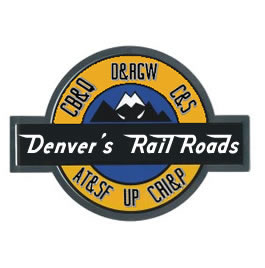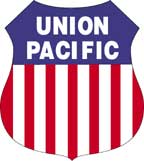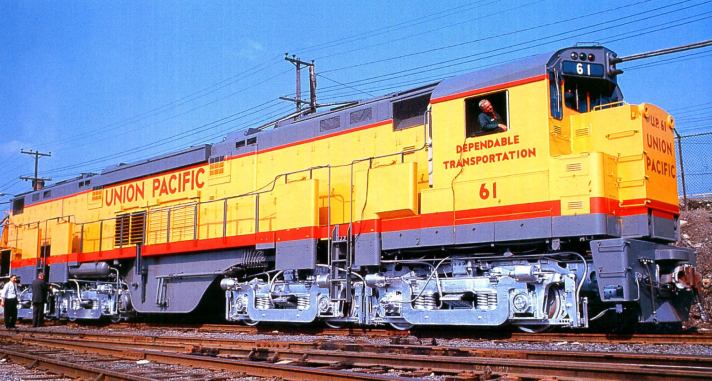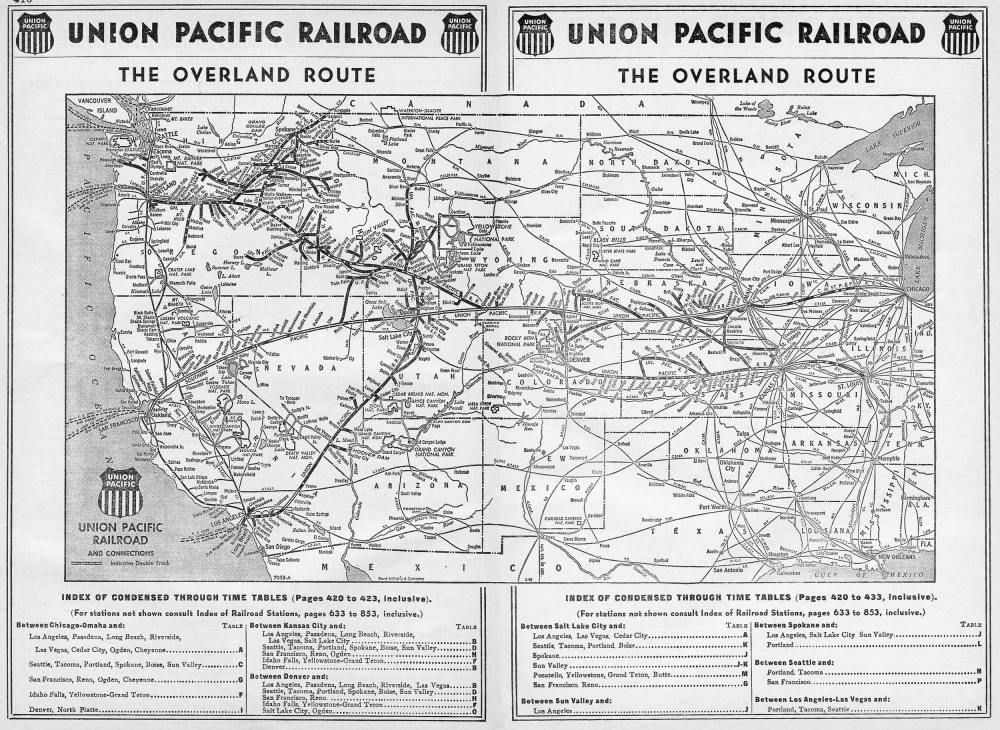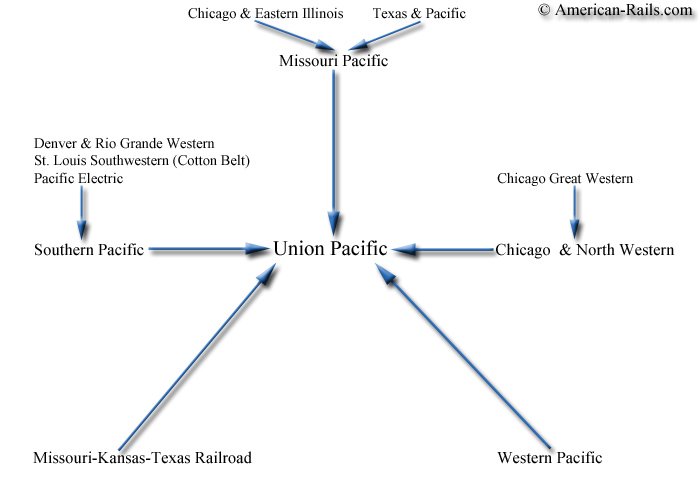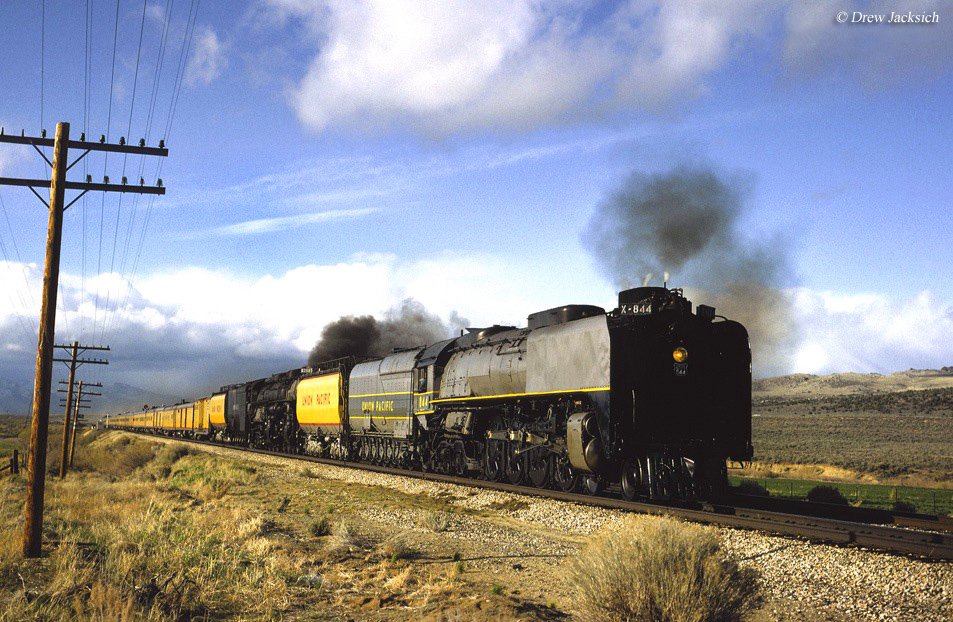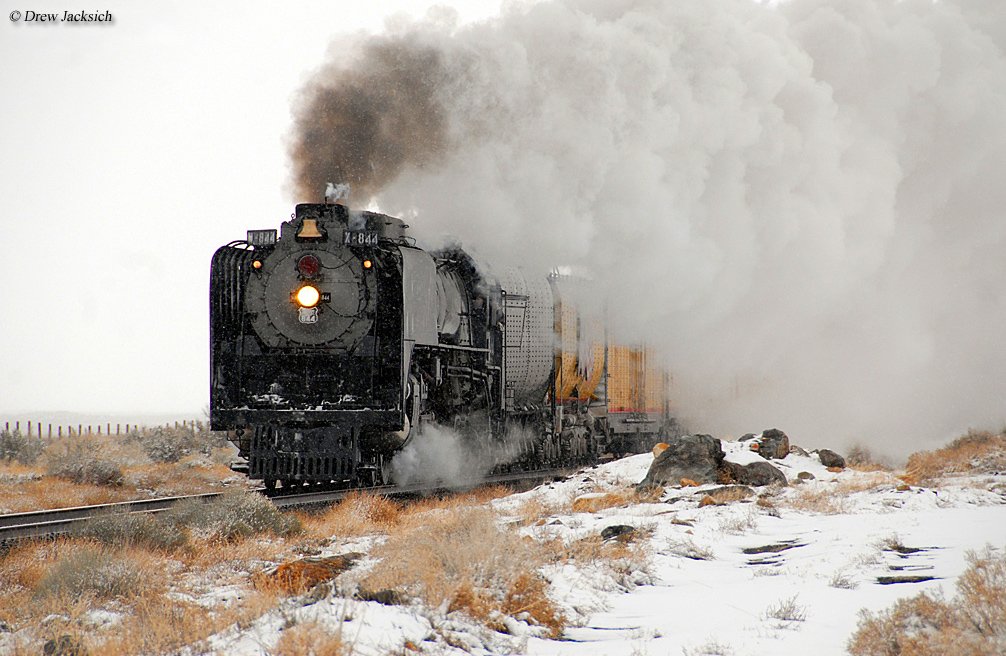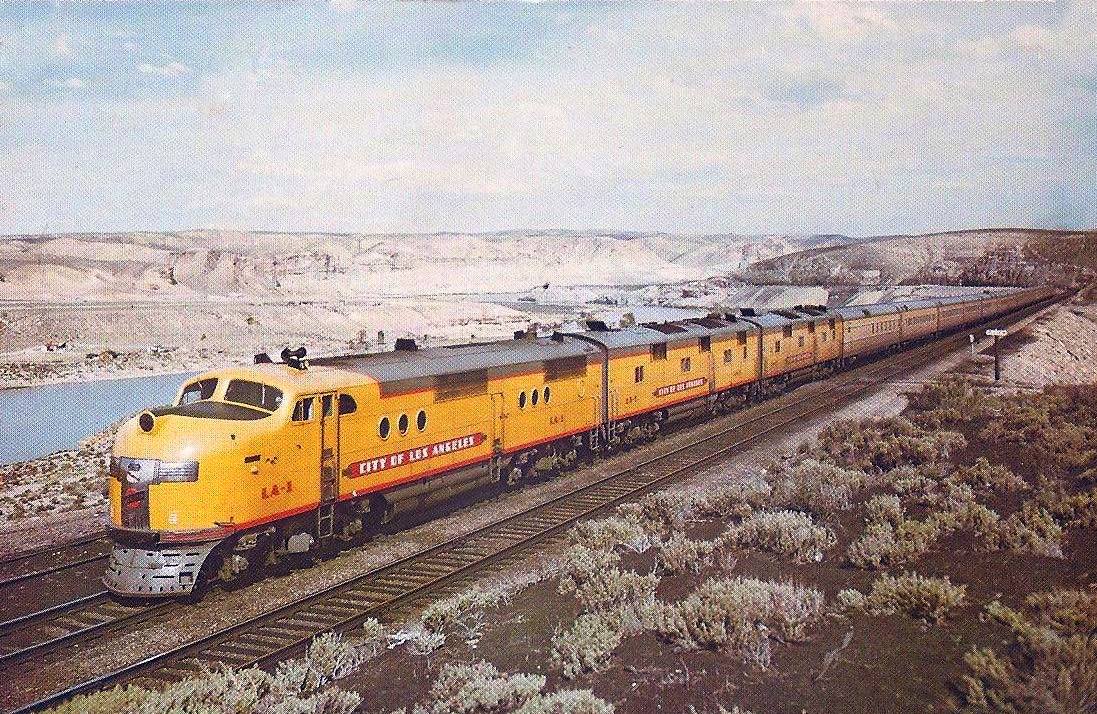Summary
The Union Pacific Railroad was one of the six railroads, along with D&RGW, C&S, CB&Q, AT&SF and CRI&P, that built and owned the Denver Union Terminal (DUT) in 1912. The UP enters Denver via Cheyenne in the North and North Platte (via CB&Q trackage rights) and Abilene in the East. UP was incorporated on July 1, 1862. The line was constructed westwardly from Council Bluffs, Iowa to meet the Central Pacific line, which was constructed eastwardly from San Francisco Bay. Subsequently UP took over three Utah roads and built or absorbed local lines that gave it access to Denver and to Portland, Oregon, and the Pacific Northwest. It also owned narrow gauge trackage into the heart of the Colorado Rockies and a standard gauge line south from Denver across New Mexico into Texas.
History
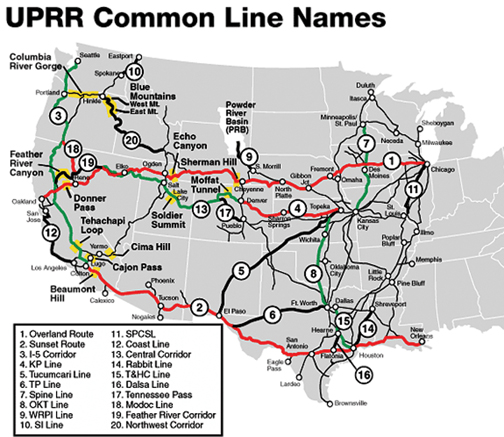
The Union Pacific (UP) is one the largest and most powerful railroads in the country. This historic system has been in operation since before the Civil War and much of the general public has at least a general knowledge of UP since it formed the eastern segment of the Transcontinental Railroad. In that time the railroad has become not only one of the most highly respected institutions in the nation (it currently ranks as a top Fortune 150 company) but also has seen nearly every major railroading event and milestone in our country’s history. Except for a troubled period at the end of the 19th century when an overextended Union Pacific fell into receivership the company has been well-managed through the years. Thanks to the its forward thinking, during the postwar period UP began gobbling up smaller, and larger, railroads. These moves propelled it into becoming the massive and successful system it is today, serving most states and communities west of the Mississippi River. Featured here is a brief history of one of America's great corporations.
You probably know the story of the Transcontinental Railroad, Union Pacific's role, and how it opened the West to vast economic opportunities. However, you may not be aware that UP has blossomed into one of America's great success stories, similar to Coca-Cola, General Electric, and the Ford Motor Company. The concept for what eventually became Union Pacific has its roots in the 1850s when then-U.S. Secretary of War Jefferson Davis (who later became president of the Confederate States of America) began surveying western routes beyond the Mississippi to link the Pacific Coast as part of the government's endeavor to complete a transcontinental rail line. There were three primary corridors chosen; a northern, central, and southern. For years, Congress could not agree upon a routing. However, following the outbreak of hostilities, a unified Northern delegation decided upon the central option. In addition, just before the war broke out, Abraham Lincoln became the country's 16th President. With the routing chosen Congress passed the Pacific Railroad Act of 1862, signed into law by President Lincoln on July 1, 1862.
Union Pacific Is Born: Building The Transcontinental Railroad
This event corresponded with Union Pacific's incorporation although some time passed before construction actually commenced. As you can see the railroad was born largely through the government and as such carried considerable startup capital, something most other ventures then did not enjoy. Despite such perks the entire project was complex and arduous; as other historians have noted it was similar in difficulty to placing a man on the moon a century later. While some states had been created when construction began, such as California, Kansas, Nevada, and Oregon there was no infrastructure in place to assist the project; virtually everything had to be hacked out of the wilderness while dealing with angry Native Americans who were extremely upset with the White Man's invasion into their ancestral hunting grounds (the U.S. Army eventually had to be called in to protect the project).
The 19th century was part of the United States' great industrial revolution, of which the railroads were key. The growing and expanding country established great manufacturing centers in the Northeast while the South generated prodigious volumes of cotton and textiles. As the railroad proved its value in the 1830s, and then blossomed into the fastest and most efficient means of transportation the world have ever seen, new economic centers such as Chicago, Indianapolis, and St. Louis flourished across the Midwest. Realizing its vast potential, the government funded the Transcontinental Railroad's construction. Its intended goals included opening the West, encouraging settlement and trade, and improving national defense by providing better protection along its coastal borders. As Joe Welsh and Kevin Holland note in their book, "Union Pacific Railroad," following the Transcontinental Railroad's completion the journey from New York to San Francisco was sliced from six months to just ten days.
While Congress mandated Union Pacific specifically to build the
line's eastern leg, the western segment was the job of Central Pacific.
This system had been organized by Collis P. Huntington, Mark Hopkins,
Leland Stanford, and Charles Crocker (the so-called "Big Four")
on June 28, 1861. It was directed to "construct a railroad and
telegraph line from the Pacific coast, at or near San Francisco, or the
navigable waters of the Sacramento River, to the eastern boundary of
California." With the passage of the Pacific Railroad Act the CP
adopted the agreement on October 7th and formally accepted it through
the Department of the Interior on December 24th. During 1863, UP turned
the first mound of soil from Omaha, Nebraska and set out westward.
This, in itself, was an interesting starting point since the railroad
was still disconnected from the national rail network; Omaha and Council
Bluffs, Iowa were separated by the mighty Missouri River and it was not
until 1872 that a new bridge opened across the waterway, linking UP with
what was later the Chicago & North Western and other carriers.

The new Union Pacific was led by President John Dix with
Vice-President Thomas Durant second in command. Durant quickly asserted
himself as the leading authority although he technically was in charge
only of UP's construction. A sly individual set upon enriching himself,
he and several associates formed Credit Mobilier in 1864, originally
known as the Pennsylvania Fiscal Agency a loan and contract company
created in 1859. Mobilier would be used as the conduit upon which
monies were distributed to Union Pacific for its construction. Perhaps
not surprisingly this setup was greatly abused; Durant used the company
to grossly overcharge UP and the government for contract work, nearly
driving the railroad into bankruptcy. The extra profits were then simply
pocketed by Durant and his partners. The issue wasn't resolved until
1872 although little punishment was ever handed down to those involved
in the corruption. By late 1865 UP had spent $500,000 but
laid only 40 miles of track. Then project engineer quit in frustration
and Durant subsequently hired Greenville Dodge to replace him.
|
|
Dodge proved far better at dealing with Durant and often ignored his boss if he felt it was in the best interest of the company. As a result, UP's western line rushed quickly across the plains, building up to 8.5 miles of new railroad per day. However, in doing so corners were cut including poor grade construction, weak bridges, and lack of sufficient tie usage. Only later, under better leadership, were these issues corrected. Despite the initial shoddy construction it was incredible the logistics the project overcame in seeing the route completed. Since the region carried few trees, and of course no way to manufacture rails, these all had to be shipped in from the East. According to Dodge it was so well organized that at no time did crews run short on supplies. The only real issue the railroad dealt with was keeping the men focused; all along the route towns sprang up to accommodate the workers during downtime. They usually spent this freedom drinking in bars and enjoying brothels, until moving on to the next settlement. As Welsh and Holland note in their book this led to the term "hell on wheels."
An American Western television series of the same name was loosely based on the phenomenon and the Transcontinental Railroad's construction. It aired from 2011 to 2016 on AMC. Another, somewhat less scandalous incident, took place as the two roads neared one another. In an effort to stake more land from the government and pocket even more money, Union Pacific and Central Pacific actually began grading lines past one another! The silliness was finally put to end when the two formally met at Promontory, Utah on May 10, 1869 with a symbolic driving of a golden spike (however, a golden spike was not actually pounded into the railroad tie as gold is much too soft). The event took place at 12:47 p.m. that day and was performed by Leland Stanford. Interestingly, even now sections of these never-used grades canbe seen. The completion of the Transcontinental Railroad was one of the great achievements in American history and was so famous that Western Union carried out lived updates. When the final spike was driven the word "done" was wired across the country.
The Union Pacific’s original main line is the Overland Route, which runs between Ogden, Utah; Omaha, Nebraska; and Chicago. The future of the Union Pacific is as wide open as the great western plains where the railroad operates. However, if the company’s past is any measure of what may happen in the years ahead, I think we can safely say that when the merger movement picks up again the railroad, and its famous shield logo, will continue to flank locomotives during their daily task of moving goods across the country. It is also important to note the company's nod to its history. Union Pacific operates an impressive heritage fleet of original equipment from its streamlined business train clad in its classic Armour yellow and gray to its stable of steam locomotives maintained at its roundhouse in Cheyenne, Wyoming.
Expanding The System
After the Transcontinental Railroad opened much work remained in upgrading the property for heavy rail service and pushing rails across other parts of the West. The Union Pacific did not immediately blossom into a wealthy system but it was rich in land and used this to its advantage. When constructing its original main line an amended Pacific Railroad Act of 1864 authorized 12,000 acres of land grants for every new mile constructed. In 1873 noted tycoon Jay Gould acquired a controlling interest in UP and set about upgrading its infrastructure while expanding its reach. Just a year after doing so he purchased controlling interest in the nearby Kansas Pacific Railway, providing UP with a southerly line linking Denver with Kansas City. It was formally consolidated in 1880. At the same time expansions continued through Utah reaching Salt Lake City in 1870 (via the Utah Central) and Butte, Montana in 1881 (Utah Northern).
In the 1880s, UP began its push into the Pacific Northwest; by 1883 it was operating more than 400 miles into Idaho via the main line at Granger, Wyoming through a subsidiary known as the Oregon Short Line. Gould's interest in the railroad ended in 1884 although this did not slow its expansion efforts; it gained control of the nearby Oregon Railway & Navigation Company in 1887 which offered new access points such as Portland and Pendleton, Oregon as well as Spokane, Washington. In 1890 the railroad formed a subsidiary known as the Union Pacific, Denver & Gulf Railway; this massive entity provided connections from Dallas/Fort Worth, Texas to Orin Junction, Wyoming linking cities such as Denver, Pueblo, Cheyenne, Amarillo and others along the way via a north-south routing. There was also narrow-gauge property that ran from Golden up Clear Creek to Central City and Silver Plume, Colorado. In all, it comprised roughly 1,600 miles of trackage.
Alas, the rapid expansion would severely cost the company; it was far too overextended in debt and fell into receivership in 1893. Union Pacific was not alone in this regard as several other railroads had experienced similar set backs which led to the great financial Panic of 1893. The UP's resulting bankruptcy broke up its network when sold at foreclosure on November 1, 1897. Then, E.H. Harriman (Edward Henry "Ned" Harriman), along with a group of investors, stepped in to acquire the former Transcontinental main line between Omaha to Ogden for $110 million. As one of the industry's great businessmen, still highly respected today, his leadership saw Union Pacific rebound and flourish. He spent more than a decade reacquiring most of the railroad's lost trackage (although the former lines south of Colorado and into Texas were reorganized as the Colorado & Southern, which eventually entered the Chicago, Burlington & Quincy's fold) and vigorously upgraded the property for modern-day operation into the 20th century.
As Welsh and Holland note in their book, by 1909, at the time of Harriman's death (September), its traffic density had increased 186% from thirteen years prior. Aside from infrastructure upgrades and new equipment, the company's major developments leading up to World War I included the consolidation of its lines in the Pacific Northwest and a new link to Los Angeles. The former included more than twenty subsidiaries which were brought together under the title of two holding companies; the Oregon Short Line Railroad and Oregon-Washington Railroad & Navigation Company. In addition, its line into Southern California proved one of its most important acquisitions. It was originally known as the San Pedro, Los Angeles & Salt Lake Railroad incorporated in 1901 through several subsidiaries linking its namesake cities (renamed the Los Angeles & Salt Lake Railroad after 1916). Following a long battle with William Andrews Clark who wanted his own route to Salt Lake City, UP and Harriman signed an agreement for 50% interested in the SPLA&SL. On August 25, 1916 it changed its name to the aforementioned LA&SL and on April 27, 1921 UP acquired full control from Clark. On January 1, 1936 these systems, and others, were formally consolidated into the railroad.
World I, Through The Mid-20th Century
Even by the early 20th century, Union Pacific was a highly respected company thanks to Harriman's visionary leadership. It had even controlled Southern Pacific between 1901 and 1912 before a Supreme Court decision forced the road to divest its holdings due to antitrust laws. UP had spent millions upgrading its subsidiary but alas the efforts had largely went for naught. In an ironic twist, it would outright purchase the SP just before century's end. The Great Depression of late 1929 hit the country, and industry, hard as financial institutions and the economy collapsed. However, thanks to the UP's sound business practices it weathered the storm relatively well, even continuing to pay a dividend during that time. It earned a great deal of publicity by making history with the country's first radical and sleek streamliner trainset, delivered to the railroad on February 25, 1934. It was a product of Pullman-Standard and the Winton Engine Company, given the moniker M-10000. While UP greatly enjoyed the publicity the train's purpose was a dollars and cents approach to bring passengers back to the rails, a tactic that largely worked into the early postwar period.
Union Pacific survived the onslaught of traffic brought about by World War II. During that time it took delivery of 25 new 4-8-8-4's from the American Locomotive Company between 1941 and 1944. Their nickname became "Big Boy" when an unknown Alco worked scrawled the name in chalk on one of the locomotive's smoke boxes during production. They were one of the most powerful steamers ever produced and began a trend of Union Pacific operating enormous locomotives. Into the diesel era such variants included the U50 and U50C (General Electric), DDA40X "Centennial" and DD35/A (Electro-Motive), and the C855 (another Alco model). It also tested gas turbine locomotives during the 1960s, a joint project from Alco/GE named "GTELs" (Gas Turbine Electric Locomotive). The whole point behind these monsters was an attempt at ways to reduce operating costs by either slicing down the number of locomotives required per train or operate longer trains. After the war UP realized passenger service was on the decline although remained strong enough into the 1950s that it continued purchasing or upgrading its fleet.
The Postwar Period
The company continued the latter program into the 1960s, offering the public some of the best and most luxurious trains during a time when most other carriers were significantly cutting back their services. Its City trains were unmatched, used by Hollywood and other dignitaries for many years. In the Chicago - California transcontinental market the only true competitor was the Santa Fe, which fielded its own fleet of highly-regarded streamliners. To maintain top-notch service, UP began systemically retrenching and combining its "Domeliners." By September of 1969 the City of Denver, City of Kansas City, City of Portland, City of San Francisco, and City of Los Angeles (along with the Challenger) were all combined into one large train east of Green River, Wyoming. While the move was a logical one (in 1946 the railroad reported nearly $65 million in passenger revenues, which was down to just $14.6 million by 1968), for those who followed the railroad they dubbed it the "City of Everywhere." Finally, the government stepped in to form Amtrak in 1971, alleviating most carriers of the burden (today, you can still glimpse the City streamlines in Union Pacific's business train).
The Modern Era
The present-day Union Pacific system began taking shape in the 1960s. By then, UP understood that growth was the only way to remain one of the West's preeminent systems. This was further realized when Northern Pacific; Great Northern; Chicago, Burlington & Quincy; and the Spokane, Portland & Seattle all merged in early 1970 to form the huge Burlington Northern system. In 1960 UP began the initial steps to merge with the Rock Island in an effort to provide it a direct link to Chicago. However, protests from other carriers was fierce and the governing body, the Interstate Commerce Commission, took more than a decade to render its decision, announcing the union could proceed in 1974. By then, the Rock was in such a dire financial condition that UP was no longer interested. The fabled Midwestern road was liquidated in 1980 and parts were purchased by surrounding carriers, which ironically included Union Pacific.
In 1980 President Jimmy Carter signed the Staggers Act into law which greatly deregulated the railroad industry making it easier to set freight rates, abandon unprofitable lines, and carry out mergers. Union Pacific subsequently acquired Missouri Pacific and the Western Pacific. In 1988 the company grew even larger when it purchased the Katy (the Missouri-Kansas-Texas Railroad) and in 1995 did the same with the Chicago & North Western, providing it access to Wyoming's Powder River Basin coal fields. Finally, just a year later in 1996 it purchased the gigantic Southern Pacific, a one-time powerhouse that by then was a company far removed from its glory days, so much so that it had been purchased by the Denver & Rio Grande Western in 1988. Today’s UP is much different from the system predating 1980 as it operates as far north as Seattle, as far west as Los Angeles/Long Beach, as far east as Minneapolis, and as far south as Dallas, Brownsville, and New Orleans (and about every west in between!).
According to Union Pacific, as of 2015 the company boasts the following credentials; 32,100 route miles, 44,500 employees, and an annual revenue of $21.81 billion (ranking only slightly behind BNSF Railway in this regard). For the general public UP operates the aforementioned business train and several historic steam locomotives including the never retired 4-8-4 #844, 4-6-6-4 #3985, and the recently acquired 4-8-8-4 "Big Boy" #4014. The latter is of particular note; when Union Pacific officially announced its intentions to restore this steamer on July 23, 2013 the railfan community was shocked and the news made headlines in the media. The move from its longtime resting place in Ponoma, California has also been widely watched and documented. Few ever thought it possible to see a Big Boy under steam again given their incredible size and the expense to do so. The locomotive will likely take a number of years to be fully restored but when she is plying the rails once more will certainly become the star attraction of the fleet.
Related Reading:
Union Pacific Through Passenger Service In Color (2011)
UP Color Guide to Freight and Passenger Equipment Volume 2 (1996)
© Copyright 2012-2022. Dennis N Turner. All Rights Reserved.
